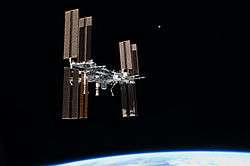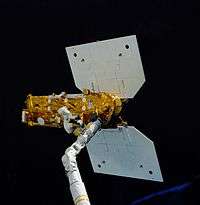List of heaviest spacecraft





List of heaviest spacecraft, is a listing of selected examples of spacecraft by mass. Spacecraft may change mass over time such as by loss of coolant. The heaviest artificial things include the space stations, various upper stages, and discarded Space Shuttle external tanks.
Examples of unmanned science spacecraft
Some additional examples of other spacecraft are included for comparison:
| Name | Mass | Notes |
|---|---|---|
| Compton Gamma Ray Obs. | 16329 kg | Orbited 1991-2000[1] |
| Hubble Space Telescope | 11110 kg | (launch mass) Space observatory in LEO[2] |
| Envisat | 8211 kg | Retired earth observing satellite[3] |
| TerreStar-1 | 6910 kg | American communications satellite |
| UARS[4] | 5,900 kg (13,000 lb) | Earth science, re-entry 2011 |
| Chandra | 5866 kg | (launch mass) X-ray telescope in earth orbit.[5] |
| Terra | 4864 kg | Earth observing satellite |
| ExoMars Trace Gas Orbiter | 4332 kg | Mars orbiter (including Schiaparelli EDM lander)[6] |
| Spektr-R (RadioAstron) | 3660 kg | Space observatory in earth orbit[7]launch mass |
| Integral | 3414 kg | Space observatory in earth orbit[8] |
| EUVE | 3280 kg | Retired space observatory[9] |
| Rossi | 2955 kg | Retired space observatory[9] |
| ERBS | 2,449 kilograms (5,399 lb) | Retired Earth observation satellite |
| Galileo | 2380 kg | Intentionally crashed into Jupiter at end-of-mission |
| COBE | 2206 kg | Retired space observatory[9] |
| Mars Reconnaissance Orbiter | 2180 kg | (launch mass) Mars orbiter[10] |
| Cassini | 2150 kg | Saturn orbiter[11] |
| Landsat 5 | 1938 kg | Retired Earth observing satellite |
| RISAT-01 | 1850 kg | Radar Imaging (ISRO) |
| Lunar Reconnaissance Orbiter | 1846 kg | Lunar orbiter |
| Juno Jupiter Orbiter | 1600 kg | Jupiter orbiter[11] |
| Swift | 1470 kg | Space observatory[9] |
| Venus Express | 1270 kg | Retired Venus orbiter |
| FUSE | 1130 kg | Retired space observatory.[9] |
| Kepler space observatory | 1052 kg | Space observatory orbiting sun |
| Spitzer | 950 kg | (2094 lb) Infrared telescope in heliocentric orbit [12] |
| MAVEN | 903 kg | Mars orbiter[11] |
| Voyager 1/2 | 815 kg | (launch mass) Space probes leaving the system[13] |
| Messenger | 485 kg | Retired Mercury orbiter |
| New Horizons | 465 kg | Space probe leaving system[14] |
| Pioneer 10/11 | 259 kg | Retired space probes |
See also
References
- ↑ NASA - CRGO
- ↑ Hubble Fact Sheet
- ↑ Envisat
- ↑ Justin Mullins, Paul Marks (20 September 2011). "Hardy 6-tonne satellite falls to Earth". New Scientist. Retrieved 25 September 2014.
"This is the largest NASA satellite to come back uncontrolled for quite a while," says Nick Johnson, chief scientist for NASA's Orbital Debris Program Office at the Johnson Space Center in Houston, Texas.
- ↑ Chandra X-ray Observatory Quick Facts
- ↑ Elizabeth Gibney (11 March 2016). "Mars launch to test collaboration between Europe and Russia". Nature News. Retrieved 14 March 2016.
- ↑ RA
- ↑ http://satellites.findthedata.org/l/426/INTErnational-Gamma-Ray-Astrophysics-Laboratory-INTEGRAL INTEGRAL
- 1 2 3 4 5 Explorers
- ↑ MRO
- 1 2 3 CubeSats to the Planets
- ↑ Spitzer fast facts
- ↑ Voyager facts
- ↑ New Horizons
This article is issued from Wikipedia - version of the 11/25/2016. The text is available under the Creative Commons Attribution/Share Alike but additional terms may apply for the media files.